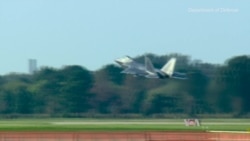As the U.S. military continues to rely heavily on air power in its combat missions abroad, a shortage of maintainers needed to keep Air Force planes flying is preventing the force from completing its training mission.
“We’re not able to produce the sorties at home for training for our pilots,” Lt. General John Cooper said in an exclusive interview with VOA.
Cooper, who is in charge of managing maintenance manpower, said the Air Force had been “living on the edge” with its maintainer numbers and hit a 3,800 maintainer shortage in 2015 due to a series of shrinking budgets from Congress.
“We were driven to the force structure that we were at last year and growing from sequestration. There’s no doubt about it. That’s in the history books,” he said.
A training increase was approved this year that added about 500 maintainers, but there's still a shortage of about 3,300.
Cooper told VOA that even if the Air Force consistently maximizes the training pipeline, the force won’t be out of the maintainer manpower hole until 2021.
More with less
Despite the lack of manpower, many maintainers at Joint Base Langley-Eustis in Virginia say they have kept a can-do attitude.
“We all understand that (having to do) more with less is happening, but I mean, regardless, jets have to fly,” said a Senior Airman named Nick, who wished to be identified only by his first name because of his commander’s concern of potential retaliation from terrorist enemies.
Major General Scott Vander Hamm, who’s in charge of fixing the fighter pilot shortage, admitted the Air Force’s hardworking ethos has led to little relief, and it will soon have to start doing “less with less” if it’s unable to get out of the manning deficit.
“We owe them capacity, more people, and we owe that now, as soon as we can,” Vander Hamm told VOA.
The Air Force is paying out bonuses to its seasoned technicians to try to keep them in the force during a time where they’re expected to keep the ongoing missions running while training a massive influx of airmen.
Creating another problem
However, while new recruits are slowly pulling the force out of the manpower hole, Colonel Pete Fesler, the commander of the First Fighter Wing at Joint Base Langley-Eustis, said they are compounding another maintenance issue.
“A bigger problem for me is not pure numbers, but the skill levels within the maintainers that I have,” Fesler told VOA. “I’ve got a very high number of inexperienced maintainers and a relatively small number of experienced maintainers to help teach those guys.”
Many at the base say that not only is there a decreasing quantity of Air Force sorties, or flights, the decreasing quality of training is creating a less-prepared future force.
“With the mission, just how fast-paced it is, they don’t get to properly train (and) show us step by step how to do things. A lot of times they’ll take over and finish themselves just to keep within the time constraints,” a young maintainer who asked to be identified only by his first name, Donovan, said.
Older maintainers told VOA that they remembered feeling like they were “carted around by the hand” during training and admitted that they were taught more effectively than they are now able to teach the new maintainers.
Lt. General Cooper said the Air Force is aware of this experience issue, which he said will likely take an additional five to seven years to fully correct. He’s hoping the retention rate for maintainers will continue to remain slightly higher than the rest of the force as it struggles through these tough years to come.
“Just everybody hang in there,” he said. “It’s going to take a little time.”







